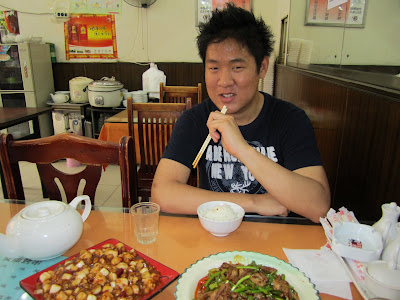Friends, you've been to many a metropolis: capitals, large towns, sprawling urban communities as far as the eye can see. Well, lets run through a mental exercise: take all of the above you've visited, add them, then multiply times ten (then toss in a couple smaller, 500,000 people cities just for good measure) and you
may begin to arrive at what Beijing is truly like. It is ginormous. The buildings are huge, and they are big at every turn. Say you get off at a random subway station (there are 126 in Beijing) nowhere near city center - the scene around you is most likely enough to pass for a downtown in any city of the world. Most western cities have but a few blocks of skyscrapers and crowded sidewalks. Here, I start feeling lonely when all I can see are 20-30 people
in close proximity moving in the same direction as me, with untold hundreds (thousands?) more in the 200 by 200 square meters of space through which I'm traveling. Unbelievable. Skyscrapers and gigantic structures abound everywhere I turn - any of them big enough to outdo main financial or governmental districts in western countries. Some the subway stations here could double as indoor tracks. If you thought NYC was big, come out to old Peking.
As you probably know, I'm no slouch. I consider College Park campus to be small, routinely pass through large swaths of Washington D.C., and have wandered up and down Manhattan many a time in full comfort. Not here - the Beijing city block is a cast iron bitch - and must have been designed for first breaking down morale (Sylvain: "Look over there, that's where we're going" -Me: "WHAT? That's like 4 miles away" -Sylvain: "Man its only a block") and then body (the pollution and Beijinger driving habits don't help any). I may walk (others call it speed-walk) for 30 minutes and cover a painfully minuscule part of the gigantic tourist map in my pocket. That, friends, is how you demoralize a man.

One of the temples scattered throughout the city and a popular tourist destination. Note the line of tour buses inside the entrance. Yep, the area was teeming with westerners.

Traditional Chinese lanterns cover the sidewalk of this restaurant street - there are many like it around. Despite it being 2 in the morning, the tables were jam packed with hungry locals scarfing down duck, pork, and rice (amongst other things); while the sidewalks were clogged with expensive sedans, mostly of German make. Communism is a bitch, you know, everyone has a beemer as big as yours.

Sanlitun district, a highly westernized area of Beijing. How westernized? In a city of over 18 million, I managed to run into the same two Americans I met the night before. Besides the Adidas and Puma stores displayed in the picture, such storied retailers as Sisley, Reiss, American Apparel, North Face, Benetton, and an official Apple Store dot the landscape. The prices are astronomical - after checking the tag on a Reiss suit, I had to leave before throwing up all over the fine-woven wool. A garment fetching $500 in D.C. was selling for over $1000 (7000RMB). Hurray for communism!

After much persuasion from Sylvain (okay, not so much, but he does like Mexican) we ended our Sanlitun crawl at the local South-of-the-Border joint.
The salsa had tomatoes in it but was loaded with red pepper powder and the quesadillas tasted distinctively Chinese, just let me tell you. I'm sure the Coronas were authentic, but we stuck with Tsingtao. Sylvain's burrito looked more like a beef sandwich wrap, but who are we to complain - this is one part of town we won't be visiting too often. How's this for random: a Ukrainian from America and a Cambodian from France eating Mexican food in the Chinese capital. I don't think we have enough cultures mixed in there. Where's a good Japanese-Brazilian girl when you need one?


























